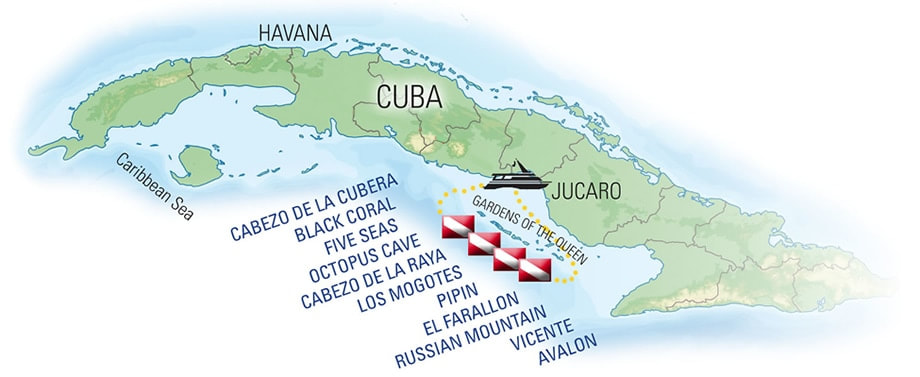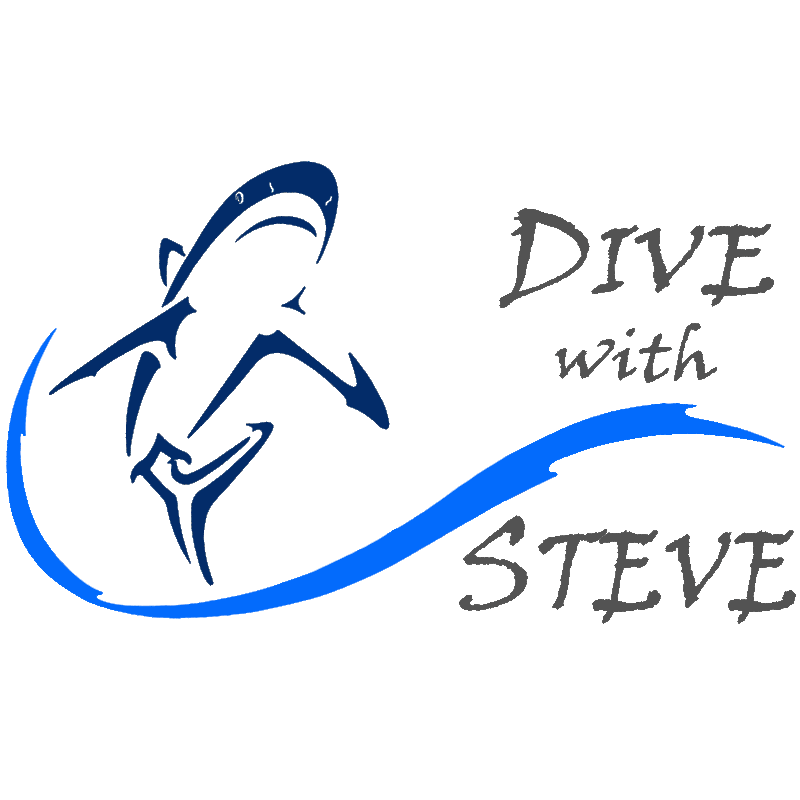DIVE SITES: GARDENS OF THE QUEEN
July 9 - 16, 2022
Cabezo de la Cubera
The depth ranges from 18-63 feet. “Cabezo” is a Cuban marine term for an isolated coral formation on a sandy bottom. This place has a “cabezo” with a circular shape, around 600 feet in diameter, which is extremely impressive with big schools of dog snapper and cuberas in the water column above the coral; mutton, yellowtail snapper schools between the coral patches, Caribbean reef sharks, different species of groupers, stingrays, turtles. After going around the coral formation, divers find a shallow wall with clouds of purple blue tangs and massive schools of tarpon crossing by.
Black Coral I
Depth ranges between 72-96 feet. Coral bands that grow higher near the edge of the platform (drop-off) are more than 30 feet high over the sand patches in the bottom between them, abundant colonies of black coral, a resident population of more than 20 Caribbean reef sharks, huge black groupers come close to the divers all the time, schools of jacks rubbing their bodies against the sharks to clean parasites away, parrotfish schools, clouds of schoolmasters and yellowtail snappers, also rainbow runners and oceanic triggerfish.
Black Coral II
Depth ranges between 60-90 feet. Impressive coral mountains near the edge of the platform, resident population of more than 25 reef sharks (Carcharinus Perezi) patrolling the coral mountains. Here, we find big colonies of black corals, large sponges, depth gorgonians, midnight parrotfish schools, king mackerel, black groupers, moray eels, hawksbill turtles, and a friendly nurse shark comes very close to divers. In the blue, passing schools of oceanic triggerfish and lonely eagle rays.
Five Seas
Depth ranges between 21-66 feet. Under the wall, there are overhangs with impressive resident schools of tarpon, black corals, and colorful sponges; divers go under and tarpons get as close as two inches from the mask to turn away with a shining silver flash. Resident population of more than 15 Caribbean reef sharks, snappers, black groupers, Goliath grouper (Epinephelus Itajara) comes very close. There is a wreck 15 meters long that was a boat from Júcaro harbor that was used as a pilot boat named Five Seas. It was sunk intentionally; the remaining parts of the boat are full of corals, sponges, schools of jacks and black corals, also green moray eels.
Octopus Cave
Depth ranges between 15-54 feet. There is a wall full of sponges and gorgonians, tarpon schools, Caribbean reef sharks and Goliath Groupers over 200 pounds, impressive schools of grunts, porgies and mullet around big pillar corals in the edge of the wall, also big clouds of Schoolmaster snappers.
Pillar corals are over 6 feet high and are cleaning stations for large and small reef fish. There is a cave at 18 feet with a horizontal development of its gallery of over 230 feet, but it is restricted and you can only explore the entrance. The cave is inhabited by “brotulas”, a blind fish, that can only be seen at night. There are also iridescent sponges with decorated crabs.
Cabezo de la Raya
Depth between 15-63 feet. Circular coral formation more than 900 feet in diameter, forming bands of coral in the sand, many stingrays in the sandy areas, nurse sharks, Caribbean reef sharks, Goliath grouper, Black and Nassau Groupers, Hawksbill turtles, King Mackerel. At the end, the dive finishes at 15 feet in a shallow wall full of reef fish, grunts, Schoolmaster snappers, parrotfish, barracudas, angelfish, blue tangs, mullet, nudibranchs, etc.
Los Mogotes
Amazing visibility, “Mogotes” is the name Cuban fishermen give to coral formations in a white sandy bottom, as they see these from the boat as darker areas in the sand. Depth ranges between 21-63 feet. There is a wall, with some overhangs full of black coral, small caves with tarpon schools especially in May, June and July, constantly patrolled by Caribbean reef sharks, big black groupers, jacks, crabs, and many reef fish in the shallow zone.
Pipin
Drop-off wall dive between 45-105 feet deep, with many coral canyons, resident school of Silky sharks (Carcharhinus falciformis) swimming near the boat all the time and Caribbean reef sharks in the deep. Black Corals, huge spotted eagle rays, tarpon, jacks, snappers, turtles. Here, you'll find big colonies of Black Corals.
El Farallon
Coral formation between 45 and 160 feet crossed by some ruptures where the corals are 30 feet high over the sand and 6 feet wide. Some of these impressive tunnels barely open in the top, allowing the rays of light to enter, forming an spectacular view. Divers go across two tunnels and then to the drop-off full of black corals and hanging sponges, black groupers, Goliath grouper, snapper, Caribbean reef sharks and silky sharks.
Russian Mountain
Drop-off, perpendicular wall, the dive goes between 66-105 feet. With large coral canyons, big schools of jacks, Black corals, huge sponges, Silky and Caribbean reef sharks; occasionally a giant lonely great hammerhead shark (Sphirna mokarran) emerges from the depth to take a quick view of the divers. Turtles, snappers, and groupers are often spotted here.
Vicente
Large cylindrical coral formations at the edge of the wall as pinnacles that rise 72 feet from a deep sandy bottom, the dive goes between 114-60 feet from top to top of these intricately decorated coral mountains, with all species of sponges, corals, gorgonians, very colorful drop-off, also large groupers, Caribbean and Silky sharks, and occasionally a curious huge great hammerhead comes up. Spotted eagle rays often fly parallel to the wall.
Avalon
Frontal edge of the reef wall, between 72-110 feet full of big Black Coral colonies and gorgonians, groupers, Silky and Caribbean reef sharks, massive iridescent sponges. It's a very colorful wall. Eagle rays are seen here often, also Goliath groupers and the occasional hammerhead shark. Some impressive canyons are found in the deeper areas of the wall.
The depth ranges from 18-63 feet. “Cabezo” is a Cuban marine term for an isolated coral formation on a sandy bottom. This place has a “cabezo” with a circular shape, around 600 feet in diameter, which is extremely impressive with big schools of dog snapper and cuberas in the water column above the coral; mutton, yellowtail snapper schools between the coral patches, Caribbean reef sharks, different species of groupers, stingrays, turtles. After going around the coral formation, divers find a shallow wall with clouds of purple blue tangs and massive schools of tarpon crossing by.
Black Coral I
Depth ranges between 72-96 feet. Coral bands that grow higher near the edge of the platform (drop-off) are more than 30 feet high over the sand patches in the bottom between them, abundant colonies of black coral, a resident population of more than 20 Caribbean reef sharks, huge black groupers come close to the divers all the time, schools of jacks rubbing their bodies against the sharks to clean parasites away, parrotfish schools, clouds of schoolmasters and yellowtail snappers, also rainbow runners and oceanic triggerfish.
Black Coral II
Depth ranges between 60-90 feet. Impressive coral mountains near the edge of the platform, resident population of more than 25 reef sharks (Carcharinus Perezi) patrolling the coral mountains. Here, we find big colonies of black corals, large sponges, depth gorgonians, midnight parrotfish schools, king mackerel, black groupers, moray eels, hawksbill turtles, and a friendly nurse shark comes very close to divers. In the blue, passing schools of oceanic triggerfish and lonely eagle rays.
Five Seas
Depth ranges between 21-66 feet. Under the wall, there are overhangs with impressive resident schools of tarpon, black corals, and colorful sponges; divers go under and tarpons get as close as two inches from the mask to turn away with a shining silver flash. Resident population of more than 15 Caribbean reef sharks, snappers, black groupers, Goliath grouper (Epinephelus Itajara) comes very close. There is a wreck 15 meters long that was a boat from Júcaro harbor that was used as a pilot boat named Five Seas. It was sunk intentionally; the remaining parts of the boat are full of corals, sponges, schools of jacks and black corals, also green moray eels.
Octopus Cave
Depth ranges between 15-54 feet. There is a wall full of sponges and gorgonians, tarpon schools, Caribbean reef sharks and Goliath Groupers over 200 pounds, impressive schools of grunts, porgies and mullet around big pillar corals in the edge of the wall, also big clouds of Schoolmaster snappers.
Pillar corals are over 6 feet high and are cleaning stations for large and small reef fish. There is a cave at 18 feet with a horizontal development of its gallery of over 230 feet, but it is restricted and you can only explore the entrance. The cave is inhabited by “brotulas”, a blind fish, that can only be seen at night. There are also iridescent sponges with decorated crabs.
Cabezo de la Raya
Depth between 15-63 feet. Circular coral formation more than 900 feet in diameter, forming bands of coral in the sand, many stingrays in the sandy areas, nurse sharks, Caribbean reef sharks, Goliath grouper, Black and Nassau Groupers, Hawksbill turtles, King Mackerel. At the end, the dive finishes at 15 feet in a shallow wall full of reef fish, grunts, Schoolmaster snappers, parrotfish, barracudas, angelfish, blue tangs, mullet, nudibranchs, etc.
Los Mogotes
Amazing visibility, “Mogotes” is the name Cuban fishermen give to coral formations in a white sandy bottom, as they see these from the boat as darker areas in the sand. Depth ranges between 21-63 feet. There is a wall, with some overhangs full of black coral, small caves with tarpon schools especially in May, June and July, constantly patrolled by Caribbean reef sharks, big black groupers, jacks, crabs, and many reef fish in the shallow zone.
Pipin
Drop-off wall dive between 45-105 feet deep, with many coral canyons, resident school of Silky sharks (Carcharhinus falciformis) swimming near the boat all the time and Caribbean reef sharks in the deep. Black Corals, huge spotted eagle rays, tarpon, jacks, snappers, turtles. Here, you'll find big colonies of Black Corals.
El Farallon
Coral formation between 45 and 160 feet crossed by some ruptures where the corals are 30 feet high over the sand and 6 feet wide. Some of these impressive tunnels barely open in the top, allowing the rays of light to enter, forming an spectacular view. Divers go across two tunnels and then to the drop-off full of black corals and hanging sponges, black groupers, Goliath grouper, snapper, Caribbean reef sharks and silky sharks.
Russian Mountain
Drop-off, perpendicular wall, the dive goes between 66-105 feet. With large coral canyons, big schools of jacks, Black corals, huge sponges, Silky and Caribbean reef sharks; occasionally a giant lonely great hammerhead shark (Sphirna mokarran) emerges from the depth to take a quick view of the divers. Turtles, snappers, and groupers are often spotted here.
Vicente
Large cylindrical coral formations at the edge of the wall as pinnacles that rise 72 feet from a deep sandy bottom, the dive goes between 114-60 feet from top to top of these intricately decorated coral mountains, with all species of sponges, corals, gorgonians, very colorful drop-off, also large groupers, Caribbean and Silky sharks, and occasionally a curious huge great hammerhead comes up. Spotted eagle rays often fly parallel to the wall.
Avalon
Frontal edge of the reef wall, between 72-110 feet full of big Black Coral colonies and gorgonians, groupers, Silky and Caribbean reef sharks, massive iridescent sponges. It's a very colorful wall. Eagle rays are seen here often, also Goliath groupers and the occasional hammerhead shark. Some impressive canyons are found in the deeper areas of the wall.
Come with us to discover Cuba's Gardens of the Queen in an immersive eco-exploration of this enigmatic underwater paradise



